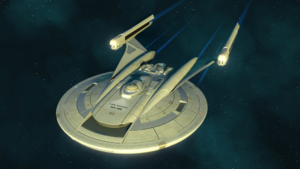| Heart of Obsidian | ||||||||||||||||||

| ||||||||||||||||||
| STV Heart of Obsidian (SE-167) | ||||||||||||||||||
| ||||||||||||||||||
Originally a Starfleet vessel, the Heart of Obsidian was commissioned in 2174, lost by 2183 and later found in 2387. Under the command of Savannah Michales with her AI companion Artemis. While originally she had a Warp 8 engine, Solas Tempus has provided equipment and facilities to provide significant system upgrades, Savannah herself is overseeing the upgrades. Originally her Warp 8 Engine will be replaced by a state of the art warp core.
Upgraded Specifications
Significant upgrades were made by Savannah withe he help of Solas Tempus.
- Cruising Speed
- Warp 6
- Maximum Speed
- Warp 9.95
- Emergency Speed
- Warp 9.975 for 38 Minutes
Auxiliary Systems
Offensive Upgrades
- 2 Forward Phaser Pulse Cannons
- 1 Forward Phaser Beam Cannon
- 2 Forward Photon Torpedo Launchers
- 2 Aft Phaser Pulse Turrets
- 1 Aft Photon Torpedo Launcher
Defensive Systems
- Deflector Shields
- Void Shields
Probes / Auxiliary Craft
History
The USS Heart of Obsidian was an experimental vessel, responsible for many of the early testing of the first Warp 8 Engine. She had a crew of 110 officers and crew with an additional 20 research and propulsion experts.
Construction
First construction in the year 2169, the design premise was to take the expansive redesign of the NX Class Starship which built the Columbia Class and use it to further warp engine design. She was designed with extensively modular drive and power systems. Every system related to warp drive and power generation were designed to be in a class of their own. The design team was credited with creating a vessel that could, in theory, operate for hundreds of years with minimal need for refitting.
Experimental Vessel
The first test flights with the Warp 8 Engine prototypes were done using a modified Warp 7 engine using the Heart of Obsidian (2174-2179). These flights gave engineers the experience needed to redesign the Warp 7 engine, used in the Daedalus Class Starship, into a new kind of warp drive. Up until 2180 the warp core was a compact device constructed in two halves laterally, injecting matter and antimatter into the center and pumping plasma into the EPS system. In 2180 the first major redesign of what a warp core could be was done, creating a much larger intermix chamber where the high energy plasma flow could be amplified.
In this new warp core design, the warp could could produce electro-plasma at a far higher temperature generating more power for engines and ship systems. The warp engine designs developed on the Heart of Obsidian were directly used as fundamental design components even as late as the Constitution Refit Class in the late 23rd century and even in the warp drive design of the Intrepid Class Starship of the 24th century.
Missing
In 2183 the vessel was testing early theoretical designs to explore the ideas which would later become the Transwarp Drive of the USS Excelsior nearly 100 years later. During a drive test, the vessel encountered a previously unknown phenomena of subspace, where a region of subspace instability could be separated into layers of subspace. This unexpected breakthrough came at a cost, as the crew attempted to shut down the drive system, the ship literally vanished into its own warp bubble. No wreckage was ever found, though the flight data recorder and log buoy were later found drifting nearly 2 lightyears away, in different directions. An extensive search was conducted, but neither wreckage nor the vessel were ever found.
Found
Found by Savannah Michaels in Void Space after an unexpected jump occurred in Savannah's experimental fighter in 2387. Savannah found the vessel with the crew very clearly dead, having been nearly liquified by the transition into void space. It is most likely that the inertial dampers did not engage properly and the crew was exposed to superluminal inertial deceleration. The vessel was claimed by Savannah as salvage and in conjunction with Solas Tempus, the vessel was registered new under the Aquarius Initiative. Under the contract with Solas Tempus for the Aquarius Initiative, the vessel is owned and operated by Savannah but Solas Tempus maintains the vessel's official registry and has agreed to provide provisions, repairs, and other material needs of the vessel.